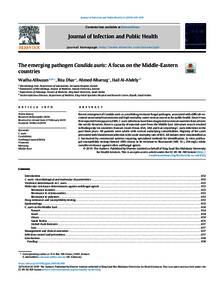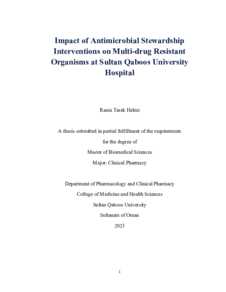Document
Evaluation of in vitro activity of ceftolozane/tazobactam and comparators against recent clinical bacterial isolates, and genomics of pseudomonas aeruginosa, klebsiella pneumoniae and escherichia coli isolates that demonstrated resistance to ceftolozane/tazobactam : data from Kuwait and Oman.
Identifier
DOI: 10.1093/jacamr/dlac035
Source
JAC-Antimicrobial Resistance. v. 4, 2, dlac035
Contributors
Dhar, Rita., Author
Mohsin, Jalila., Author
Khamis, Feryal., Author
Mokaddas, Eiman., Author
Abdullah, Abrar., Author
Mustafa, Abu Salim., Author
Otero, Aurelio., Author
Wanis, Paulette., Author
Matar, Samar Hussien., Author
Khalil, Sherif., Author
Alekseeva, Irina., Author
Young, Katherine., Author
Country
United Kingdom.
City
Oxford.
Publisher
Oxford University Press.
Gregorian
2022-04-01
Language
English
English abstract
Background: The treatment options for infections caused by MDR Gram-negative bacteria have been limited, especially for infections caused by bacteria that produce carbapenemases and/or ESBLs. Ceftolozane/tazobactam is a cephalosporin/β-lactamase inhibitor developed to treat Gram-negative bacteria. Methods: Ceftolozane/tazobactam and 14 comparators (amikacin, aztreonam, cefepime, cefotaxime, cefoxitin, ceftazidime, ceftriaxone, ciprofloxacin, colistin, ertapenem, imipenem, levofloxacin, meropenem and piperacillin/tazobactam) were evaluated against Pseudomonas aeruginosa and Enterobacterales isolates collected from Kuwait and Oman (n=606) during 2016-17. In addition, further analysis of resistance mechanisms to ceftolozane/tazobactam was done utilizing WGS. Non-susceptible isolates from ceftolozane/tazobactam surveillance were selected for analysis. Overall, 35 strains underwent WGS. Results: Among isolates from Kuwait, susceptibility of P. aeruginosa, Escherichia coli and Klebsiella pneumoniae to ceftolozane/tazobactam was 79.8%, 95.7% and 87.5%, respectively, and from Oman was 92.3%, 93.1% and 88.5%, respectively. No P. aeruginosa with a ceftolozane/tazobactam MIC 32mg/L encoded β-lactamases besides normal chromosomal enzymes (PDC variants or OXA-50-like) whereas all but one P. aeruginosa isolate with MIC >32mg/L encoded either MBLs (60%), VEB-1 (19%) or additional OXAs (3.7%). Conclusions: Colistin followed by ceftolozane/tazobactam showed the greatest activity against P. aeruginosa. Enterobacterales showed more susceptibility to ceftolozane/tazobactam than to piperacillin/tazobactam, but meropenem and colistin showed better activity.
ISSN
2632-1823
Category
Journal articles



